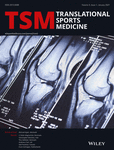Corticomotor excitability of the gluteus maximus in individuals with chronic ankle instability: A pilot study
Abstract
The purpose of this study was to compare gluteus maximus (GM) corticomotor excitability between individuals with and without chronic ankle instability (CAI) and examine associations between GM excitability and clinical outcomes. We recruited 30 participants (F:20, M:10, 22.8 ± 2.6 years, 169.4 ± 7.9 cm, 68.7 ± 12.4 kg) classified as CAI, copers (COP), or controls (CON). We measured active motor threshold (AMT) and motor evoked potential (MEP) of the GM. We also assessed star excursion balance test (SEBT) performance and the Foot and Ankle Ability Measure (FAAM). One-way ANOVAs tested group differences in outcomes. Associations between outcomes were tested with Pearson's product moment correlations. CAI did not differ in AMT compared to CON (P = .14) or COP (P = .19). COP had an increased AMT compared to CON (P = .04, d = 1.77 [0.31, 2.96]). CAI had lower SEBT anterior (P = .03, d = −1.33 [−2.24, −0.31]), posterolateral (P = .02, d = −1.59 [−2.51, −0.52]), posteromedial (P = .02, d = −1.44 [−2.36, −0.41]), and composite (P < .01, d = −1.94 [0.53, −2.90]) compared to COP. CAI had lower FAAM-ADL and FAAM-Sport scores than COP and CON. There was a small correlation between AMT and SEBT composite (r = .47, P = .04). Individuals with CAI did not differ in GM excitability compared to individuals without CAI. Copers’ reduced excitability suggests they possess unique central nervous system adaptations after sustaining an ankle sprain.
CONFLICT OF INTEREST
The authors have no conflicts of interest to report.




